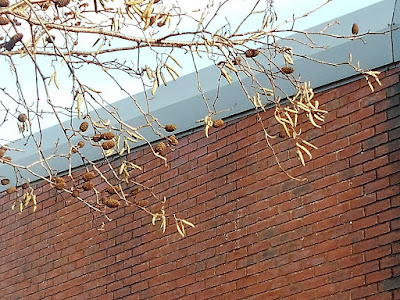Britain's native alder is the rather sticky-leaved Alnus glutinosa. It is widespread in our county, growing beside rivers and streams and is also frequent in wet woodlands, where it produces its catkins from February through to early April. Its seeds are interesting because they contain air-tight cavities and these, together with an oil protecting them from wet, allow them to float unharmed throughout the winter to germinate on mud or damp soil in the spring.
The Italian Alder, Alnus cordata, is widely planted both as a street tree and in gardens and in urban areas it is perhaps the commonest alder. Its flowering times are similar to those of our native alder but the species is rarely self-sown. Perhaps our climate is too far removed from its home in southern Italy and Corsica.
The third species likely to be encountered is the exceptionally hardy Grey Alder, Alnus incana. I have certainly seen it growing beside streams in, for example, Byfield, but its habit of suckering makes it a potential nuisance in gardens. However, it flowers early with its catkins appearing in January or even December, so when I saw an alder in Daventry today I immediately suspected, as it bore hundreds of catkins, that it was this species. But...
 |
| Alder catkins. Daventry, 24 January, 2017 |
What was I looking at? Perhaps it wasn't A. incana at all; the trunk just wasn't right; the word 'incana' means hoary or grey, and the trunk I photographed seemed at best only slightly grey-ish. Furthermore this specimen showed no signs of suckers - and yet the male catkins were present and obvious.
Did the female catkins offer a clue? Only last year's 'cones' were to be found and they were of no obvious help but when I gave them a tap a few seeds fell out; they were flat and wrinkled, rather than the smooth and plump propagules I might expect. From this I concluded that the trees - and there were several in the area - were probably hybrids, perhaps A. glutinosa x A. incana, otherwise referred to as A. x pubescens.
 |
| Last year's female 'cones, now dry and hard. Daventry, 24 January, 2017 |
Does all this matter? Probably not (but at least it kept me from grinding my teeth over the latest choleric outpourings of the Daily Mail and surely that has to be 'a good thing').
One interesting point is perhaps worth making: Italian Alder is host to an aphid, Crypturaphis grassii. It is a distinctively coloured insect found on the foliage of this species and nowhere else, and since its first recording in 1998 is rapidly spreading across Britain. If it turns up on this tree, that will be conclusive. So aldermen/women, watch this space.
One interesting point is perhaps worth making: Italian Alder is host to an aphid, Crypturaphis grassii. It is a distinctively coloured insect found on the foliage of this species and nowhere else, and since its first recording in 1998 is rapidly spreading across Britain. If it turns up on this tree, that will be conclusive. So aldermen/women, watch this space.

No comments:
Post a Comment